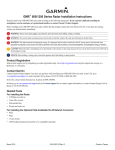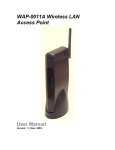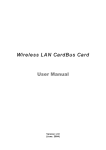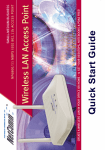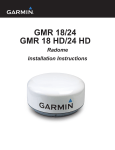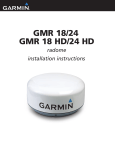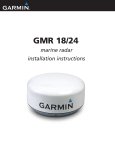Download Raymarine 1200 Owner`s manual
Transcript
GMR™ 400/600/1200 xHD Radar Installation Instructions Properly install your GMR 400/600/1200 xHD radar according to the following instructions. If you experience difficulty installing the chartplotter, seek the assistance of a professional installer, or contact Garmin® Product Support. Before installing your GMR 400/600/1200 xHD radar, confirm that the package contains the items listed on the box. If any parts are missing, contact your Garmin dealer immediately. Warning: Always wear safety goggles, ear protection, and a dust mask when drilling, cutting, or sanding. Warning: The selected radar mounting location must be able to hold the weight of the radar and withstand any inertial forces. Warning: The radar transmits electromagnetic energy. It is important that the radar is turned off or the DC power input is disconnected when personnel are required to come close to the radar to perform work on the radar assembly or associated equipment. Electromagnetic energy is harmful. CAUTION: When the radar is transmitting, do not look directly at the antenna at close range, because the eyes are the most sensitive part of the body to electromagnetic energy. Notice: When drilling or cutting, always check the opposite side of the drilling or cutting surface. Product Registration Help us better support you by completing our online registration today. Go to http://my.garmin.com. Keep the original sales receipt, or a photocopy, in a safe place. Contact Garmin Contact Garmin Product Support if you have any questions while installing your GMR 400/600/1200 xHD radar. In the USA, go to www.garmin.com/support, or contact Garmin USA by phone at (913) 397.8200 or (800) 800.1020. In the UK, contact Garmin (Europe) Ltd. by phone at 0808 2380000. In Europe, go to www.garmin.com/support and click Contact Support for in-country support information, or contact Garmin (Europe) Ltd. by phone at +44 (0) 870.8501241. Needed Tools For Installing the Radar: • • • • #2 Phillips screwdriver 5 mm Allen wrench Drill and drill bits Wrench and socket set For Installing the Optional Field-Installable RJ-45 Network Connector: • • • • Knife Pliers 15 mm wrench AMP modular-plug hand tool and die set or compatible equivalent September 2012 190-01266-02 Rev. D Printed in Taiwan Selecting a Location When selecting a location to install the GMR 400/600/1200 xHD radar, consider the following: • An ideal mounting location is high above the keel line of the ship with a minimal part of the structure or rigging blocking the radar beam. Obstructions in the path of the radar beam may cause blind and shadow sectors, or generate false echoes. The higher the installation position, the farther the radar can detect targets. • Avoid mounting on the same level as smoke stacks, horizontal spreaders, or crosstrees on a mast. • Do not install the radar near heat sources where it may be exposed to smoke or hot air from smoke stacks or heat from lights. • The mounting surface or platform should be sturdy enough to support the weight of the radar and any inertial forces, as flat as possible, and parallel with the water line. • Garmin recommends mounting the radar out of range of personnel (vertical beam width above head height). When properly installed and operated, the use of this radar conforms to the requirements of ANSI/IEEE C95.1-1992 Standard for Safety Levels with Respect to Human Exposure to Radio Frequency Electromagnetic Fields. IEC 60936-1 clause 3-27.1 states maximum distances from the antenna at which Radio Frequency (RF) levels can be expected. ◦◦ ◦◦ ◦◦ ◦◦ ◦◦ ◦◦ GMR 404 xHD (100W/m squared = 55 in. [1.4 m]) (10W/m squared = 178 in. [4.5 m]) GMR 406 xHD (100W/m squared = 65 in. [1.7 m]) (10W/m squared = 200 in. [5.1 m]) GMR 604 xHD (100W/m squared = 67 in. [1.7 m]) (10W/m squared = 217 in. [5.5 m]) GMR 606 xHD (100W/m squared = 79 in. [2 m]) (10W/m squared = 244 in. [6.2 m]) GMR 1204 xHD (100W/m squared = 99 in. [2.5 m]) (10W/m squared = 307 in. [7.8 m]) GMR 1206 xHD (100W/m squared = 111 in. [2.8 m]) (10W/m squared = 343 in. [8.7 m]) Caution: When the radar is transmitting, do not look directly at the antenna at close range (the eyes are the most sensitive part of the body to electromagnetic energy). • A compass safe distance must be maintained between the compass and the radar. The compass safe distance is measured from the center point of the compass to the nearest point on the radar. ◦◦ Standard compass = 35 7/16 in. (90 cm) ◦◦ Standby Steering and Emergency compasses = 31 1/2 in. (80 cm) • Mount other electronics and cables more than 7 ft. (2 m) from the path of a radar beam. A radar beam can spread 25° vertically above and below the radiating element of the radar. For vessels with higher bow angles at cruise speed, you can lower the angle so that the beam points slightly downward to the waterline while at rest. Shims may be used as necessary. 12.5° 12.5° • Install the radar away from antennas or other electronics. GPS antennas should be located above or below the radar beam path of the radar. Mount at least 3 ft. (1 m) from any equipment transmitting or cables carrying radio signals, such as VHF radios, cables, and antennas. In the case of SSB radios, the distance should be increased to 7 ft. (2 m). 2 GMR 400/600/1200 xHD Installation Instructions Installing the Mounting Studs and Seals 1. Remove the hatch on the front of pedestal by loosening the screw and lifting the hatch off of the hinges as shown in Figure 1. 2. Apply the included anti-seize compound to the threads of the four M10 x 71 mounting studs. 3. Use a 5 mm Allen wrench to install the M10 x 71 mounting studs (Figure 2) in the pedestal matching the hole pattern that was selected. Tighten the mounting studs until they bottom out in the pedestal. Do not overtighten the studs to avoid damaging the pedestal. The mounting studs have a thread-locking patch applied at the factory. 4. Install the seals onto the pedestal (Figure 3). Figure 1 Figure 2 Figure 3 Important Steel-Structure Mounting Concerns Notice: Improperly installing the radar on a steel surface will cause damage to the radar housing. The radar housing will become corroded when improperly installed on a steel surface. To avoid corrosion of the radar housing, the housing must be isolated from the steel surface using nylon washers, with enough space between the radar housing and the steel surface to allow water to drain. Also, one of the four mounting studs must be properly connected to ground, and the ground connection must be properly isolated from the steel surface with a nylon washer and coated with marine sealant (page 6). Rubber seal Steel surface Nylon washers Grounding wire (needed only on one mounting stud) Marine sealant Mounting the Radar Mount the radar with either end pointed toward the bow. Ensure it is mounted along the Bow-Stern Axis line indicated on the GMR 400/600/1200 Series Mounting Template. If the end with the hatch is pointed toward the bow, the Front of Boat Offset setting on the chartplotter must be set to 180° (Figure 4). To adjust the Front of Boat Offset on the chartplotter, see page 8. To mount the radar: 1. (Skip to step two if you are using a pre-drilled Garmin compatible Furuno® or Raymarine® mount.) Determine a suitable mounting location and tape the Mounting Template in place. The Mounting Template has two hole patterns: Option A and Option B. Determine the most appropriate patterns from the two patterns available on the Mounting Template (Option A or Option B). Use a 1/2 in. (13 mm) bit to drill the four mounting holes. 2. Hoist the radar into position using the supplied strap. Position the strap over the ends of the antenna mount as shown in Figure 5. Ensure that you position the strap as close to the radar as possible. GMR 400/600/1200 xHD Installation Instructions 3 3. Fasten the radar to the mounting surface using the M10 hex nuts, spring washers, and flat washers in the order shown in Figure 6. The M10 nuts should be torqued to 130 lbf-in (11 lbf-ft) (1.5 kgf-m). Bearing Offset = 0° flat washer Stern Bow Waveguide protective cover spring washer M10 hex nut Bearing Offset = 180° Figure 4 Figure 5 Figure 6 Mounting the Antenna 1. Remove the protective cover from the pedestal wave guide. 2. Verify that the antenna wave guide is aligned with the pedestal wave guide. Slide the antenna onto the pedestal. Align the waveguide faces 3. Secure the antenna to the pedestal using the 8 mm hex bolts, flat washers, and spring washers. The 8 mm bolts should be torqued to 70 lbf-in (6 lbf-ft) (.81 kgf-m). Antenna Pedestal Installing the Voltage Converter Unit The included voltage converter unit is needed to supply a specific constant voltage to the radar. When installing the voltage converter unit, consider the following: • The voltage converter requires an input voltage of 10–40 Vdc (20–40 Vdc for the GMR 1204 and GMR 1206). • You must connect the converter to the boat battery through a 15 A slow-blow fuse. Distance Gauge • Garmin recommends that you install the voltage converter as close as possible to the selected 9 ft. 10 in. (3 m) 12 AWG power source. 16 ft. 4 in. (5 m) 10 AWG • For optimal performance, connect the voltage converter housing to the RF ground of the vessel. 21 ft. 3 in. (6.5 m) 9 AWG • If the input wires need to be extended, follow the recommendations in the wire gauge table. 26 ft. 2 in. (8 m) 8 AWG ◦◦ If the wires are extended, use the supplied heat-shrink butt connectors. Wire Gauge Table ◦◦ After the connector is crimped, heat the connector to shrink it and provide a water resistant fit. 4 GMR 400/600/1200 xHD Installation Instructions GMR 400/600/1200 xHD Voltage Converter Unit + Sample boat fuse block To radar Voltage Converter Unit To power 15 A slow-blow fuse 10–40 Vdc (20–40 Vdc for the GMR 1204 and 1206) - To RF ground Connecting the Voltage Converter to a Boat Fuse Block Installing the Power and Network Cables Route the cable as needed, based on the type of mount you are using. When installing the power and network cables, consider the following: • To ensure safety, use the appropriate tie-wraps, fasteners, and sealant to secure the cable along a route and through any bulkhead or deck. Avoid running the cable near moving objects, high-heat sources, or through doorways and bilges. • Avoid installing the cable next to or parallel to other cables, such as radio antenna lines or power cables. This is essential to avoid interference to or from other equipment. If this is not possible, shield the cable with metal conduit or a form of EMI shielding. • You may need to drill a 1 1/4 in. (31.7 mm) hole for routing the power/network cable. Garmin provides a rubber cable grommet to cover the cable installation hole. ◦◦ The grommet does NOT provide a waterproof seal. To waterproof the grommet, apply a marine sealant. ◦◦ You can purchase additional cable grommets through Garmin or a Garmin dealer. • Use the optional field-installable RJ-45 network connector (included) to create a custom-length Garmin Marine Network cable if needed (see page 9). To install the cable assembly: 1. Align the notch and locking ring on the power cable to the power connector. Press the 2-pin power cable to the power connector. Tighten the power-cable locking ring clockwise until it is firmly sealed.. 2. Press the RJ-45 marine network cable to the RJ-45 socket. Tighten the RJ-45 locking ring clockwise until it is firmly sealed. 3. Route the power and network cables through the front of the radar (Figure 7), or through a hole drilled through the mounting surface (Figure 8). Avoid excessively bending or twisting the cables. 4. Install the hatch on the front of the radar. Figure 7 GMR 400/600/1200 xHD Installation Instructions RJ-45 network cable connector Power connector Figure 8 5 Connecting the Radar to Power Through the Voltage Converter Connect the radar power cable (red and black) to the voltage converter output cable (red and black) using the supplied heat-shrink crimp connectors. After crimping the connections, heat the connectors to shrink the housing for a water resistant fit. Notice: If you choose to cut the radar power cable, you must reconnect the in-line fuse holder. Connect the radar to the water ground of the vessel using an 8 gauge copper cable (not included). Secure the ground wire to the radar housing using one of the four mounting studs, an M10 nut, and flat washer. Cover the ground-wire connection, mounting stud, and nut in marine sealant. GMR 400/600/1200 xHD radar Garmin marine network cable Radar power cable 7.5 A fuse Power converter + - To water ground 10–40 Vdc (20–40 Vdc for the GMR 1204 and 1206) To RF ground Power Wiring Diagram 6 GMR 400/600/1200 xHD Installation Instructions Connecting the Radar to the Garmin Marine Network For a stand-alone network (chartplotter and radar only), attach the RJ-45 marine network cable to the RJ-45 socket on the back of the chartplotter. For an expanded network (including a chartplotter, radar, a GMS 10, etc.), attach the RJ-45 marine network cable to an open RJ-45 socket on the GMS 10 network expander. Tighten the RJ-45 locking ring clockwise until it is firmly sealed. GMR 400/600/1200 xHD radar Garmin Marine Networkcompatible chartplotter Stand-Alone Garmin Marine Network Example GSD 22 sounder unit GMR 400/600/1200 xHD radar xxxx GMS 10 marine network port expander To transducer x x x x xxxxxxxxxxxxxxxxxxx GDL 30/30A XM weather receiver Garmin GPSMAP 3000 series chartplotter Garmin GPSMAP 4000/5000 series chartplotter Expanded Garmin Marine Network Example NOTE: Each component of the expanded network must be installed according to its installation instructions. These diagrams only show how a GMR 404/406 radar interacts with a network and do not show proper wiring for other network components. NOTE: Every device connected to the Garmin Marine Network must be connected to the power supply for the boat. These diagrams show the network connections; however, they do not show the power connections. Wire each device according to the appropriate installation instructions. GMR 400/600/1200 xHD Installation Instructions 7 Configuring the Radar After you install the radar, you must prepare the chartplotter or the Garmin Marine network to properly use the radar. 1. Update the chartplotter or Garmin Marine Network software. 2. Enter the radar antenna size. 3. Set the Front of Boat Offset if necessary. Updating the Chartplotter or the Garmin Marine Network If you have a GPSMAP 4000, 5000, 6000, 7000, or 700 series chartplotter, use a blank SD card to update the chartplotter or the network according to the instructions in the chartplotter owner’s manual. If you have a GPSMAP 3000 series chartplotter, use a blank Garmin Data Card to update the chartplotter or the network according to the instructions in the chartplotter owner’s manual. Download the latest software from www.garmin.com. Entering the Radar Antenna Size Using a chartplotter, specify the size of your radar antenna (4 foot or 6 foot). Until you specify the antenna size, the warning “Radar Needs Configured” appears on the chartplotter. NOTE: Ensure you specify the correct antenna size on your chartplotter to obtain optimum performance. To enter the radar antenna size on a GPSMAP 4000,5000, 6000, 7000, or 700 series chartplotter: 1. From the Home screen, select Radar. 2 From the Radar screen, select Menu > Radar Setup > Antenna Size. 3. Select the correct antenna size, 4 foot or 6 foot. To enter the radar antenna size on a GPSMAP 3000 series chartplotter: 1. Press the PAGE key to switch to the Radar page. 2. Press the Setup softkey to open the setup page. 3. Using the ROCKER, highlight the Advanced tab, then the Antenna Size field, and press ENTER. 4. Select the correct antenna size, 4 foot or 6 foot, and press ENTER. Changing the Front of Boat Offset To measure potential radar offset: 1. Using a magnetic compass, take an optical bearing of a stationary target located within viewable range. 2. Measure the target bearing on the radar. 3. If the bearing deviation is more than +/- 1°, further correct the Front of Boat Offset. bow To change the Front of Boat Offset on a GPSMAP 4000, 5000, 6000, 7000, or 700 series chartplotter: 1. From the Home screen, select Radar. 2. From the Radar screen, select Radar Setup > Front of Boat. 3. Enter an offset value, then select Back. To change the Front of Boat Offset on a GPSMAP 3000 series chartplotter: 1. From the Radar page, press the Setup softkey to open the setup page. 2. From the Setup page, using the ROCKER, select the Advanced tab. 3. Highlight the Front of Boat Offset slider, and press ENTER. 4. Adjust the value accordingly. The preview window changes as you adjust the slider. 5. After an offset is determined, press ENTER to save, and press QUIT to return to the Radar page. 8 Front of Boat Offset = 0° stern Depending on the radar installation, you may need to change the Front of Boat Offset. If the radar installation requires a 180° offset, change the Front of Boat Offset to 180° and test the radar. If the Front of Boat Offset needs further adjustment, measure the radar offset and change the offset using the following procedures. Front of boat Offset = 180° GMR 400/600/1200 xHD Installation Instructions Installing the Field-Installable RJ-45 Network Connector (Optional) A field-installable RJ-45 network connector is provided for you to create a network cable that is the correct length for your installation. ➊ O-Ring ➋ RJ-45 modular plug ➌ Ethernet cable termination ➌ Copper tape strip (not shown) ➊ ➋ Preparing the Network Cable 1. Cleanly cut your Ethernet cable to the desired length. Retain the cut RJ-45 connector for Step 4. 2. Remove the strain-relief nut from the cable-connection housing and slide it onto the cut end of the cable as shown. 3. Feed the cut cable end through the connection housing as shown. Cut end of cable Strain relief Connection housing 4. Examine the RJ-45 connector removed in Step 1 and compare it to the wire positions in the table below. Note which cable side, A or B, was removed in Step 1. Position Wire Color—Main/Stripe Side A Side B 1 White/Orange White/Green 2 Orange Green 3 White/Green White/Orange 4 Blue Blue 5 White/Blue White/Blue 6 Green Orange 7 White/Brown White/Brown 8 Brown Brown Position 8 Position 1 NOTE: The Garmin Marine Network requires cross-over cables not exceeding 100 meters between devices. When constructing a custom cable from bulk wire, you must create both a Side A and Side B. 5. Prepare the cable for plug installation: • Using a sharp knife, insert the blade between the cable shield and jacket. Slit the jacket 5/8" back from the trimmed end of the cable. 9/16 in. (14 mm) • Peel the jacket back and remove the slit portion. • Trim the shield and Mylar film away from wires. Be careful not to cut any of the wires. • Fold the drain wire back over the jacket and trim to approximately 9/16 in. (14 mm). • Untwist the wire pairs enough to ensure a proper connection. Drain • Arrange individual wires in proper order according to the table shown above. For example, if you have identified wire the end of the cable in Step 4 as Side A, arrange the wires for Side A. If you are constructing a custom cable from bulk wire, you need to make both a Side A and a Side B connection. • Trim the wire ends to an even length, leaving approximately 9/16 in. (14 mm) from the ends to the jacket edge. • Place the drain wire on the jacket. Wrap the supplied copper tape around cable as close to the edge of the jacket as possible. • Using a pair of pliers, squeeze the copper tape to pre-form the cable jacket end for easier insertion into the plug. Use caution to avoid damaging the copper tape. GMR 400/600/1200 xHD Installation Instructions 9 Installing the Network Connector 1. Keeping the wires in proper sequence, insert them into the modular plug until the ends bottom out inside the plug. Visually inspect the wires to verify proper order before continuing. If any wires are not in the correct position, remove the plug and rearrange the wires. 2. Using an AMP Modular Plug Hand Tool and Die Set (or compatible equivalent), crimp the plug onto the wires following the recommended procedure of the crimp-tool manufacturer. 3. After the plug is crimped, align the release tab on the plug with the corresponding notch in the cable-connection housing. Depress the tab and push the cable through the connection housing until the plug is securely seated in the plug cavity. Release tab 4. Screw the strain relief nut onto the housing and tighten it snugly with a 15 mm wrench. Be careful not to overtighten the nut. 5. Install the O-ring onto the housing. The cable is now ready to use. O-Ring 10 GMR 400/600/1200 xHD Installation Instructions Unit Dimensions 17 11/32 in. (440.8 mm) 7 7/8 in. (200 mm) 5 29/32 in. (150 mm) 5 33/64 in. (140 mm) L 7 7/8 in. (200 mm) 12 11/32 in. (313.5 mm) 12 7/8 in. (326.8 mm) Model L GMR 404/604/1204 xHD 51 19/32 in. (1310 mm) GMR 406/606/1206 xHD 75 45/64 in. (1923 mm) GMR 400/600/1200 xHD Installation Instructions 11 Specifications Pedestal (Physical) Weight: 45.9 lb. (20.82 kg) Power Cable: 49 ft. 2 35/64 in. (15 m) long Network Cable: 49 ft. 2 35/64 in. (15 m) long GMR 400/600 xHD Transmit Power: GMR 400 xHD: 4 kW Transmit Power: GMR 600 xHD: 6 kW Transmitter Frequency: 9410 ±30 MHz Input Voltage: 10–40 Vdc (with the Voltage Converter Unit) Typical Input Power: 55 W Input Power (100 kn wind): 145 W max Range/Pulse Width/PRF (nm/nsec/Hz): 0.125 – 0.5/75/3980 0.750 - 1/185/3975 1.5/235/3200 2.0/283/2750 3.0/370/1970 4.0/440/1736 6.0 – 12/535/1407 16 – 36/1032/800 48 – 72/1032/500 Antenna Rotation: 24 rpm and 48 rpm Max wind load: 100 knots Receiver Noise Figure: Less than 4 dB Environmental: Temp: from 14 to 140º F (from -10 to +60º C) Humidity: 95% at 95º F (35º C) Rel Wind: 100 kn Waterproof to IEC 60529 IPX6 Range: 65.5 ft. (20 m) mini, 72 nm max Range discrimination: 65.5 ft. (20 m) Radar interference: Anti-jamming algorithm Clutter suppression: Sea clutter and rain clutter GMR 1200 xHD Transmit Power: 12 kW Transmitter Frequency: 9410 ±30 MHz Input Voltage: 20–40 Vdc (with the Voltage Converter Unit) Typical Input Power: 65 W Input Power (100 kn wind): 155 W max 12 Range/Pulse Width/PRF (nm/nsec/Hz): 0.125 – 0.5/75/3980 0.750 - 1/185/3975 1.5/235/3200 2.0/283/2750 3.0/370/1970 4.0/440/1736 6.0 – 12/535/1407 16 – 36/1032/800 48 – 72/1032/500 Antenna Rotation: 24 rpm and 48 rpm Max wind load: 100 knots Receiver Noise Figure: Less than 4 dB Environmental: Temp: from 14 to 140º F (from -10 to +60º C) Humidity: 95% at 95º F (35º C) Rel Wind: 100 kn Waterproof to IEC 60529 IPX6 Range: 65.5 ft. (20 m) min, 72 nm max Range discrimination: 65.5 ft. (20 m) Radar interference: Anti-jamming algorithm Clutter suppression: Sea clutter and rain clutter 4 ft Open-Array Antenna Type: End-fed slotted waveguide Horizontal Beamwidth: 1.8 degrees Horizontal Sidelobes: -23 dB within ±10 degrees of main -30 dB outside ±10 degrees of main Vertical Beamwidth: 24 degrees Antenna Gain: 29 dB Polarization: Horizontal Input Return Loss: Better than -20 dB Weight: 12.2 lb. (5.53 kg) 6 ft. Open-Array Antenna Type: End-fed slotted waveguide Horizontal Beamwidth: 1.1 degrees Horizontal Sidelobes: -25 dB within ±10 degrees of main -30 dB outside ±10 degrees of main Vertical Beamwidth: 24 degrees Antenna Gain: 30 dB Polarization: Horizontal Input Return Loss: Better than -20 dB Weight: 16.9 lb. (7.67 kg) Radar Display Features Presentation Modes: North up, Course up, Heading up VRM/EBL: 1 user adjustable (GPSMAP 4000/5000/6000/7000/700 series chartplotters) 2 user adjustable, capable of floating (GPSMAP 3000 series chartplotters) Bearing Accuracy: 1 degree Controls: Auto & manual gain adjust; manual or auto (AFC) receiver tuning; manual adjust for rain clutter and for sea clutter. Radar/Chart Overlay: Overlay mode is supported. Also has split overlay with standard radar presentation Harbor Mode: Optimized radar performance in the harbor Offshore Mode: Optimized radar performance offshore Dual Range Mode: Simultaneous operation of two ranges displayed in split screen format User selectable ranges of 1/8 nm to 3 nm on left side and 1/8 nm to 72 nm on right side Timed Transmit: (GPSMAP 3000 series chartplotters) user-specified transmission and standby time. Sentry: (GPSMAP 4000/5000/6000/7000/700 series chartplotters) user-adjustable timedtransmit mode Zoom Mode: 2x, 4x (GPSMAP 3000 series chartplotters only) Trails (Wakes): Short, Medium, Long (GPSMAP 3000 series chartplotters only) Guard Zone Alarm: 2 guard zones—user adjustable Off center Function: Look ahead (GPSMAP 4000/5000/6000/7000/700 series chartplotters) Look ahead, Auto Shift and Manual (GPSMAP 3000 series chartplotters) Antenna RPM: Selectable to 24 or 48 rpm MARPA: Tracks up to 10 MARPA targets for radar plotting and collision avoidance (Heading sensor is required) GMR 400/600/1200 xHD Installation Instructions Warnings Failure to avoid the following potentially hazardous situations could result in an accident or collision resulting in death or serious injury. • The radar transmits electromagnetic energy. Ensure that the radar has been installed according to the recommendations given in this guide, and that all personnel are clear of the radar before switching to transmit mode. • When navigating, carefully compare information displayed on the unit to all available navigation sources, including information from visual sightings, and maps. For safety, always resolve any discrepancies or questions before continuing navigation. • Use the electronic chart in the unit only to facilitate, not to replace, the use of authorized government charts. Official government charts and notices to mariners contain all information needed to navigate safely. • Use this unit only as a navigational aid. Do not attempt to use the unit for any purpose requiring precise measurement of direction, distance, location, or topography. WARNING: This product, its packaging, and its components contain chemicals known to the State of California to cause cancer, birth defects, or reproductive harm. This Notice is provided in accordance with California’s Proposition 65. See www.garmin.com/prop65 for more information. WARNING: Do not cut the fuse holder from the red wire. The fuse holder must remain in place for the Garmin radar to function correctly. Removing the inline fuse holder may damage your boat's circuitry. CAUTION: Check with local authorities for any operational restrictions or licensing requirements that may apply while using this device. CAUTION: Do not use the GMR 400/600/1200 xHD radar on inland Belgium waters because the radars exceed authorized Belgian power transmission levels for inland waters. FCC Compliance The GMR 400/600/1200 xHD radar complies with Part 80 of the FCC rules. It has received a grant of equipment authorization, issued under the authority of the FCC. This equipment generates, uses, and can radiate radio frequency energy and, if not installed and used in accordance with the instructions, may cause harmful interference to radio communications. However, there is no guarantee that interference will not occur in a particular installation. If this equipment does cause harmful interference to radio or television reception, which can be determined by turning the equipment off and on, the user is encouraged to try to correct the interference by one of the following measures: • • • • Reorient or relocate the receiving antenna. Increase the separation between the equipment and the receiver. Connect the equipment into an outlet on a circuit different from that to which the receiver is connected. Consult the dealer or an experienced radio/TV technician for help. Industry Canada Compliance The GMR 400/600/1200 xHD radar complies with Industry Canada Standard RSS-138. Declaration of Conformity (DoC) Hereby, Garmin, declares that this product is in compliance with the essential requirements and other relevant provisions of Directive 1999/5/ EC. To view the full Declaration of Conformity, go to www.garmin.com/compliance. Software License Agreement BY USING THE GARMIN 600/1200 SERIES RADAR, YOU AGREE TO BE BOUND BY THE TERMS AND CONDITIONS OF THE FOLLOWING SOFTWARE LICENSE AGREEMENT. PLEASE READ THIS AGREEMENT CAREFULLY. Garmin grants you a limited license to use the software embedded in this device (the “Software”) in binary executable form in the normal operation of the product. Title, ownership rights, and intellectual property rights in and to the Software remain in Garmin. You acknowledge that the Software is the property of Garmin and is protected under the United States of America copyright laws and international copyright treaties. You further acknowledge that the structure, organization, and code of the Software are valuable trade secrets of Garmin and that the Software in source code form remains a valuable trade secret of Garmin. You agree not to decompile, disassemble, modify, reverse assemble, reverse engineer, or reduce to human readable form the Software or any part thereof or create any derivative works based on the Software. You agree not to export or re-export the Software to any country in violation of the export control laws of the United States of America. GMR 400/600/1200 xHD Installation Instructions 13 Limited Warranty This Garmin product is warranted to be free from defects in materials or workmanship for one year from the date of purchase. Within this period, Garmin will, at its sole option, repair or replace any components that fail in normal use. Such repairs or replacement will be made at no charge to the customer for parts or labor, provided that the customer shall be responsible for any transportation cost. This warranty does not apply to: (i) cosmetic damage, such as scratches, nicks and dents; (ii) consumable parts, such as batteries, unless product damage has occurred due to a defect in materials or workmanship; (iii) damage caused by accident, abuse, misuse, water, flood, fire, or other acts of nature or external causes; (iv) damage caused by service performed by anyone who is not an authorized service provider of Garmin; or (v) damage to a product that has been modified or altered without the written permission of Garmin. In addition, Garmin reserves the right to refuse warranty claims against products or services that are obtained and/or used in contravention of the laws of any country. This product is intended to be used only as a travel aid and must not be used for any purpose requiring precise measurement of direction, distance, location or topography. Garmin makes no warranty as to the accuracy or completeness of map data in this product. THE WARRANTIES AND REMEDIES CONTAINED HEREIN ARE EXCLUSIVE AND IN LIEU OF ALL OTHER WARRANTIES EXPRESS, IMPLIED, OR STATUTORY, INCLUDING ANY LIABILITY ARISING UNDER ANY WARRANTY OF MERCHANTABILITY OR FITNESS FOR A PARTICULAR PURPOSE, STATUTORY OR OTHERWISE. THIS WARRANTY GIVES YOU SPECIFIC LEGAL RIGHTS, WHICH MAY VARY FROM STATE TO STATE. IN NO EVENT SHALL GARMIN BE LIABLE FOR ANY INCIDENTAL, SPECIAL, INDIRECT OR CONSEQUENTIAL DAMAGES, INCLUDING, WITHOUT LIMITATION, DAMAGES FOR ANY TRAFFIC FINES OR CITATIONS, WHETHER RESULTING FROM THE USE, MISUSE OR INABILITY TO USE THE PRODUCT OR FROM DEFECTS IN THE PRODUCT. SOME STATES DO NOT ALLOW THE EXCLUSION OF INCIDENTAL OR CONSEQUENTIAL DAMAGES, SO THE ABOVE LIMITATIONS MAY NOT APPLY TO YOU. Garmin retains the exclusive right to repair or replace (with a new or newly-overhauled replacement product) the device or software or offer a full refund of the purchase price at its sole discretion. SUCH REMEDY SHALL BE YOUR SOLE AND EXCLUSIVE REMEDY FOR ANY BREACH OF WARRANTY. To obtain warranty service, contact your local Garmin authorized dealer or call Garmin Product Support for shipping instructions and an RMA tracking number. Securely pack the device and a copy of the original sales receipt, which is required as the proof of purchase for warranty repairs. Write the tracking number clearly on the outside of the package. Send the device, freight charges prepaid, to any Garmin warranty service station. Online Auction Purchases: Products purchased through online auctions are not eligible for warranty coverage. Online auction confirmations are not accepted for warranty verification. To obtain warranty service, an original or copy of the sales receipt from the original retailer is required. Garmin will not replace missing components from any package purchased through an online auction. International Purchases: A separate warranty may be provided by international distributors for devices purchased outside the United States depending on the country. If applicable, this warranty is provided by the local in-country distributor and this distributor provides local service for your device. Distributor warranties are only valid in the area of intended distribution. Devices purchased in the United States or Canada must be returned to the Garmin service center in the United Kingdom, the United States, Canada, or Taiwan for service. Australian Purchases: Our goods come with guarantees that cannot be excluded under the Australian Consumer Law. You are entitled to a replacement or refund for a major failure and for compensation for any other reasonably foreseeable loss or damage. You are also entitled to have the goods repaired or replaced if the goods fail to be of acceptable quality and the failure does not amount to a major failure. The benefits under our Limited Warranty are in addition to other rights and remedies under applicable law in relation to the products. Garmin Australasia Unit 19, 167 Prospect Highway Seven Hills, NSW, Australia, 2147 Phone: 1800 822 235 Garmin’s Marine Warranty Policy: Certain Garmin Marine products in certain areas have a longer warranty period and additional terms and conditions. Go to www.garmin.com/support/warranty.html for more details and to see if your product is covered under Garmin’s Marine Warranty Policy. 14 GMR 400/600/1200 xHD Installation Instructions GMR 400/600/1200 xHD Installation Instructions 15 All rights reserved. Except as expressly provided herein, no part of this manual may be reproduced, copied, transmitted, disseminated, downloaded or stored in any storage medium, for any purpose without the express prior written consent of Garmin. Garmin hereby grants permission to download a single copy of this manual onto a hard drive or other electronic storage medium to be viewed and to print one copy of this manual or of any revision hereto, provided that such electronic or printed copy of this manual must contain the complete text of this copyright notice and provided further that any unauthorized commercial distribution of this manual or any revision hereto is strictly prohibited. Information in this document is subject to change without notice. Garmin reserves the right to change or improve its products and to make changes in the content without obligation to notify any person or organization of such changes or improvements. Visit the Garmin Web site (www.garmin.com) for current updates and supplemental information concerning the use and operation of this and other Garmin products. Garmin®, the Garmin logo, and GPSMAP® are trademarks of Garmin Ltd. or its subsidiaries, registered in the USA and other countries. GMR™ and myGarmin™ are trademarks of Garmin Ltd. or its subsidiaries. These trademarks may not be used without the express permission of Garmin. Furuno® is a registered trademark of Furuno Electric Co., Ltd. Raymarine® is a registered trademark of Raymarine Limited. For the latest free software updates (excluding map data) throughout the life of your Garmin products, visit the Garmin Web site at www.garmin.com. © 2010–2012 Garmin Ltd. or its subsidiaries Garmin International, Inc. 1200 East 151st Street, Olathe, Kansas 66062, USA Garmin (Europe) Ltd. Liberty House, Hounsdown Business Park, Southampton, Hampshire, SO40 9LR UK Garmin Corporation No. 68, Zhangshu 2nd Road, Xizhi Dist., New Taipei City, 221, Taiwan (R.O.C.) www.garmin.com September 2012 190-01266-02 Rev. D Printed in Taiwan
















